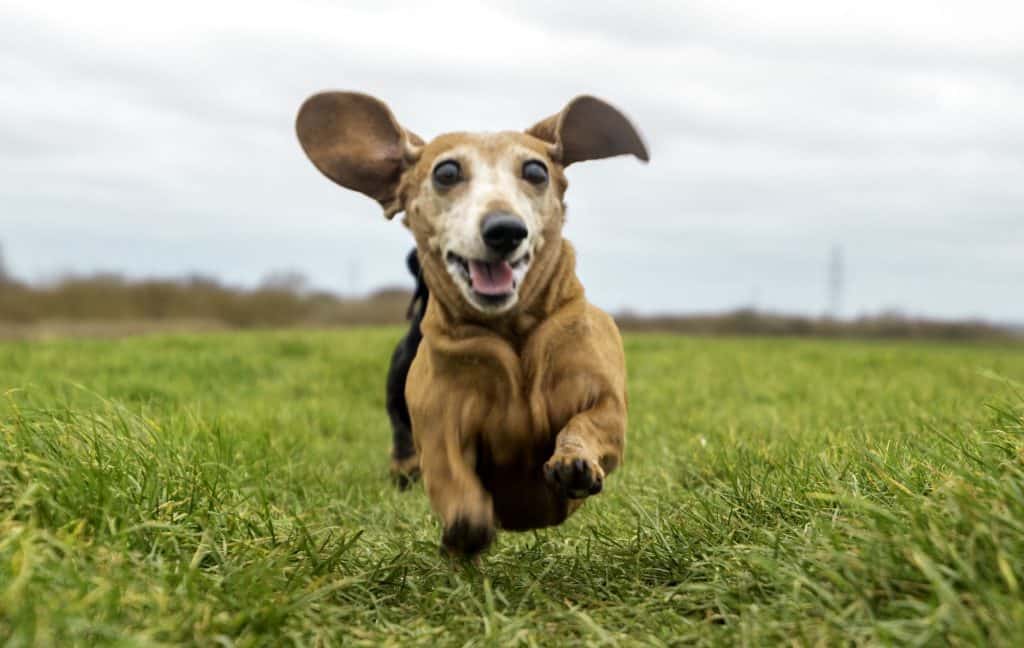Are Dachsunds Easy to Train?
Dachshunds seem like a great breed to raise, but are they easy to house train? After some further research, I found what it’s like to train a Dachshund.
Are Dachsunds Easy to Train?
Dachshunds can be trained different commands both in their adult and puppy stages of life although it is easier to teach dachshunds while they are young. Dachshunds are prone to be dominant so it is important to teach them commands to establish your dominance and gain their respect.
Several people purchase dachshunds without thinking much about the training process. However, it is important to look into how to train them so you can live in harmony with your pet.
Training a Dachshund
Dachshunds can have a mind of their own which makes them difficult to train, but there are ways to do it if you are prepared!
The most important part about training is going in with a positive attitude. If you are positive about it and have patience, the training will go better. It is also important to remember to be firm.
When you are firm with your dog, they will see that you are the alpha. They won’t be able to walk all over you and get whatever they want because they won’t be the dog in charge of the family.
Being firm with them also shows your love for them. It shows you are respectful enough not to yell, but loving enough to not let them do whatever they want.
As you start training your dachshund, whenever he or she does something wrong, give a firm answer of “no”. Do not hit or physically harm them. Do not yell at them either. Yelling or hitting won’t get them to do the command correctly. If anything, doing those things will make your pet lose trust in you or become mad.
If a dachshund feels improperly handled, they can snap back and become mean. If your dog does something wrong, tell him or her “no” in a steady, firm voice.
When a dachshund does something right or follows a command correctly, give them praise! Words of affirmation like “Good Job!” or “Good Boy” are great ways to let him know he or she is doing well. As you tell them these uplifting words, also pet them so they physically can feel your love.
The dog will realize that what they are doing is right because they are rewarded by kind words and gentlephysical touch. This will encourage your dog to continue these actions.
Dogs respond quite well to love languages, as seen from above. Another love language I think that should be added is receiving food. Well, that seems to go along with receiving gifts. So dogs also respond well to recieving gifts as their love language. Food gifts, in particular. Who doesn’t love to eat food?
If you give your pet treats when they do well, they are more likely to do it again. The best kind of treats are ones they can swallow quickly so you can say more commands instead of waiting for them to chew it up. Be careful not to give them too many treats, you wouldn’t want them to get sick of the treats. Treats are special and should be treated as such.
Dogs have a short attention span, especially puppies. The time you spend with training should be short, but repeated multiple times throughout the day. For example, if teaching to sit, focus on it for a couple of minutes and offer them one of their love languages–words of affirmation, touch, or treat!
Training Dachshund Puppies
The age that most people generally begin teaching dachshunds tricks, commands, and potty trianing is when they are puppies. At about 3-7 weeks is when the puppy begin their first experience training.
They listen to sounds, start playing with toys, and venture a little further away from their mothers. Once they reach 8 weeks old, it is the perfect age for puppies to be trained.
Some tricks that can be taught to puppies are: sit, stop, come, spin, and all those classic commands. Dachshunds can be difficult to train compared to other dogs.
If this difficulty comes up for you, look into command schools for dogs and training books. These resources can offer more support on how to achieve better results.
Here’s a book that could help you with training your dachshund, especially when they are difficult: “The Everything Dachshund Book” by Joan Walker. Follow the link to view the book on Amazon:
When teaching a command, a great way to begin is with treats like when teaching a dachshund to sit. Hold a treat to their nose so they see the treat, then lift up the treat so his head follows the treat but his lower half goes down. Once he is in the sitting position, say “sit” and give him the reward.
Notice how this example is a short little command that can be done in a few minutes. It is important to practice a command several times throughout the day, and not all at once.
Instead of forcing your dog to learn commands for an hour, try repetivie commands, at different times in the day. It will start to click better after repetition.
The difference between teaching a puppy and a dog is that one is able to learn faster. So it’s possible to train a dog, it just will be at a slower pace. It may be difficult because dogs have grown already in their ways.
When teaching a dachshund adult dog, it helps when you have them on a leash so they won’t run away and will pay attention to you. With patience and practice, it can be possible.
Postive vs. Negative Training– Which is Better?

Earlier we talked about how it is good to reward your dog with a treat or words of affirmation if they do something good. But what if they do something bad? Will they understand that they did a bad behavior if there are no consequences for it?
The best way to train a puppy or a dog is to train them in a balanced manner. A balanced training looks like someone giving their dog positive feedback when they do something right and correcting them if they do something wrong.
Ways to correct them when doing something wrong would be: speaking with a certain tone of voice, correcting words or using a collar/leash. Physical abuse is not needed to correct negatively.
The balanced way of training is to help the dog understand what is good from what is a bad action. The more they start to understand between good and bad, the better at following commands they will be.
As they learn from good criticism, they will grow to love and respect you, making training go a lot smoother.
It’s like when a kid plays with another kid and steals their toy– the one being robbed will become frustrated and cry. Now the first child learn that if they steal a toy, the other child will cry.
When your dachshund jumps up on other people, you can use a stern voice “No” or pull them away with the collar saying “no” so they understand that it is not okay.
Overtime they will learn, but this may be more difficult if they are an older dog. Remember to have patience and keep practicing with your dog using this strategy.
The best way to train any dog is to use both positive and negative training–positive reinforcement when they do something right and negative feedback when they do something wrong.
Potty Training Dachshunds with a Crate
Potty training a dachshund inside the house may be difficult but with some tips, you’ll be good to go. It’s been said that dachshunds can never fully be house potty trained, but it just depends.
With a positive attidtude, patience, and if you train your dog early on, you have more chances of being successful.
Some of the popular potty training strategies are using a crate, using puppy pads and newspapers.
The first one, a crate, some people find to be unethical for their dog. A crate is like a kennel or a cage that confinds a pet inside. Some people don’t agree with this because they feel it keeps their dog prisoner. This depends on what you hope to achieve.
A crate can be an excellent choice for potty training because it teaches them that bathroom time is right after they come out of the kennel.
Bring your dog outside or to the potty area each time after you bring them out of the crate. Dogs are known for not doing their business when they are in an area where they sleep and eat.
It is a perfect place to keep them restrained from going potty all over the house. This method can work if you consistently bring them outside or out for a potty break.
If your intentions are to leave them in a crate all day and not be home to take them out, then this might not be the best option. Dogs do better when taken out and have time to socialize and exercise, especially dachshunds.
A crate can be a comforting place as well. The crate can be a place of familiar comfort for the dog so they feel at peace. It is nice for some dogs to have their own little area. Dachshunds love to be around people and their families, so if you choose to do the crate idea, make sure to bring them out often.
If your dachshund continues to pee inside, it would be a good idea to use a crate for when you are asleep or away from home.
Especially if this habit continues, never leave your dog alone in the house without your supervision. If they wander around and are bored, they are likely to just go whenever.
Potty training with a Pad or Newspapers

Another method of potty training is to set up a potty pad or newspaper area for them. This designated area is a place for the puppy to do his business inside. Bring him here immediately after he or she eats their food.
If you want the dog to become familiar with a certain area to do his business at, then it is important they can recognize a familiar scent. Your dog can’t recognize a scent if you clean up their mess every time, though. I’m not saying leave their mess out for days, no that would stink! There is a better way to help them smell out the potty area.
When they use the potty area, place several newspapers or paper towels, or other material of your choice if you don’t read the newspaper anymore. Once your dachshund is done doing his business, save one of the newspapers. (Not the one that they actually did their business on!) Then place that newspaper with the new, fresh paper for their next visit to the potty corner.
Your dog hopefully will smell the familiar scent of their past business and start to come to the potty corner on their own. This will take patience and time as stated previously.
Dachshunds are difficult to train because they have a mind of their own. If the indoor isn’t working for your pet, there is always
Bringing your dog often outside is the best option for the ultimate clean potty training experience. (Because you know they won’t do their business anywhere inside the house) Also, the outdoors are great because you don’t have to do immediate cleanup work. No gross smells for you! Save on spending money on cleaning supplies and puppy pads!
Different Tricks to Teach Your Dog
- Roll over
- Bang, Bang
- Fetch
- Dance
- Turn Around
- Bow
- Speak
- Stay/Go
There are several different tricks you can train your dog to learn. Most of them can be successful with practice and with treats. For example, when teaching your dog to turn around, use a treat and move the treat above the dog’s head in a circle.
The dog will learn to follow this motion, following the treat, as you practice doing this over and over. Say “turn around” as you do the motion so that begin to be familiar with the words.
The same can be done for other tricks, your dog will obey and follow the treats. Dogs can learn words so use them when you are doing ticks like fetch.
When retrieving a ball, say the word ball and “go get the ball!” so they learn the names of items. Once they hear the words and are rewarded, they will start to remember these things.
Dogs can also recognize names of people. When they are called to go to see a person, have that person call the dog over. Once they hear the names and recognize the person calling them, they will begin to identify names and follow through with commands better.
Dachshund Personalities
Knowing how to train a dog is important but knowing what your dogs’ personality is crucial. Every breed of dog comes with a different set of personalities and this can effect the way they are trained.
Dachshunds love to bark and can bark very loudly. They will bark at strangers and especially if they think someone is imposing on their property or home.
Dachshunds have a history of being difficult to train. Some even say it is impossible to potty train them. Dachshund personalities can be stubborn and difficult, but they make excellent guard dogs with their protective natures.
Dachshunds are naturally dominant and have a history of hunting badgers. This means they might not like being told what to do. It is important to train a dachshund in the proper way so that they don’t try to be the leader over you.
Is it Better to Train Dachshunds Puppies or Dogs?
Ideally it is better to train puppies. The best time is when puppies hit 8 weeks old. Between 8 and 12 weeks is when dachshund puppies will be willing to learn commands.
This is before they reach the time when their dominance will come out. When they reach 12-16 weeks, this is when they will begin to assert dominance. It is important to teach them to listen and follow your commands instead of you following their commands.
Giving into your dog or allowing them to act however they want when they are young can be harmful. When they continue to grow, they will learn there are no rules and become more difficult to train.
However, if you purchased a dachshund dog, there are still ways to teach an old dog some new tricks. By following the steps stated above using the balanced method of training, your dog will learn to trust you and learn over time.
Related Questions:
Do dachshunds love to bark a lot? Dachshunds can bark a lot, especially if they are in a protective situation. They are naturally hunting dogs and are very loyal to their owners. When strangers are nearby or they hear noises, it is likely you will hear them bark.
Are dachshunds good pets? Dachshunds can be great companions that stay loyal to their owners. They are natural guard dogs and can be protective. They offer plenty of love to their families and can be great around children if dachshunds are handled with care.

